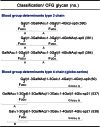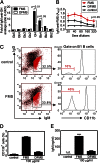Immunization of fucose-containing polysaccharides from Reishi mushroom induces antibodies to tumor-associated Globo H-series epitopes
- PMID: 23908400
- PMCID: PMC3752246
- DOI: 10.1073/pnas.1312457110
Immunization of fucose-containing polysaccharides from Reishi mushroom induces antibodies to tumor-associated Globo H-series epitopes
Abstract
Carbohydrate-based vaccines have shown therapeutic efficacy for infectious disease and cancer. The mushroom Ganoderma lucidum (Reishi) containing complex polysaccharides has been used as antitumor supplement, but the mechanism of immune response has rarely been studied. Here, we show that the mice immunized with a l-fucose (Fuc)-enriched Reishi polysaccharide fraction (designated as FMS) induce antibodies against murine Lewis lung carcinoma cells, with increased antibody-mediated cytotoxicity and reduced production of tumor-associated inflammatory mediators (in particular, monocyte chemoattractant protein-1). The mice showed a significant increase in the peritoneal B1 B-cell population, suggesting FMS-mediated anti-glycan IgM production. Furthermore, the glycan microarray analysis of FMS-induced antisera displayed a high specificity toward tumor-associated glycans, with the antigenic structure located in the nonreducing termini (i.e., Fucα1-2Galβ1-3GalNAc-R, where Gal, GalNAc, and R represent, respectively, D-galactose, D-N-acetyl galactosamine, and reducing end), typically found in Globo H and related tumor antigens. The composition of FMS contains mainly the backbone of 1,4-mannan and 1,6-α-galactan and through the Fucα1-2Gal, Fucα1-3/4Man, Fucα1-4Xyl, and Fucα1-2Fuc linkages (where Man and Xyl represent d-mannose and d-xylose, respectively), underlying the molecular basis of the FMS-induced IgM antibodies against tumor-specific glycans.
Keywords: anti-Globo H antibody; antitumor activity; mushroom polysaccharide.
Conflict of interest statement
The authors declare no conflict of interest.
Figures




Similar articles
-
Studies on the immuno-modulating and antitumor activities of Ganoderma lucidum (Reishi) polysaccharides: functional and proteomic analyses of a fucose-containing glycoprotein fraction responsible for the activities.Bioorg Med Chem. 2002 Apr;10(4):1057-62. doi: 10.1016/s0968-0896(01)00377-7. Bioorg Med Chem. 2002. PMID: 11836115
-
Immunogenicity study of Globo H analogues with modification at the reducing or nonreducing end of the tumor antigen.J Am Chem Soc. 2014 Dec 3;136(48):16844-53. doi: 10.1021/ja508040d. Epub 2014 Nov 20. J Am Chem Soc. 2014. PMID: 25371992
-
Ganoderma lucidum polysaccharide (GLP) enhances antitumor immune response by regulating differentiation and inhibition of MDSCs via a CARD9-NF-κB-IDO pathway.Biosci Rep. 2020 Jun 26;40(6):BSR20201170. doi: 10.1042/BSR20201170. Biosci Rep. 2020. PMID: 32530032 Free PMC article.
-
Molecular mechanisms of bioactive polysaccharides from Ganoderma lucidum (Lingzhi), a review.Int J Biol Macromol. 2020 May 1;150:765-774. doi: 10.1016/j.ijbiomac.2020.02.035. Epub 2020 Feb 6. Int J Biol Macromol. 2020. PMID: 32035956 Review.
-
Ganoderma lucidum Polysaccharides as An Anti-cancer Agent.Anticancer Agents Med Chem. 2018;18(5):667-674. doi: 10.2174/1871520617666171113121246. Anticancer Agents Med Chem. 2018. PMID: 29141563 Free PMC article. Review.
Cited by
-
1,4-β-d-Glucomannan from Dendrobium officinale Activates NF-кB via TLR4 to Regulate the Immune Response.Molecules. 2018 Oct 16;23(10):2658. doi: 10.3390/molecules23102658. Molecules. 2018. PMID: 30332800 Free PMC article.
-
Evaluation of Prebiotic Potential of Crude Polysaccharides Extracted from Wild Lentinus polychrous and Lentinus squarrosulus and Their Application for a Formulation of a Novel Lyophilized Synbiotic.Foods. 2024 Jan 16;13(2):287. doi: 10.3390/foods13020287. Foods. 2024. PMID: 38254588 Free PMC article.
-
B cells in tumor metastasis: friend or foe?Int J Biol Sci. 2023 Apr 29;19(8):2382-2393. doi: 10.7150/ijbs.79482. eCollection 2023. Int J Biol Sci. 2023. PMID: 37215990 Free PMC article. Review.
-
Tramesan, a novel polysaccharide from Trametes versicolor. Structural characterization and biological effects.PLoS One. 2017 Aug 22;12(8):e0171412. doi: 10.1371/journal.pone.0171412. eCollection 2017. PLoS One. 2017. PMID: 28829786 Free PMC article.
-
Serum antibody screening using glycan arrays.Chem Soc Rev. 2024 Mar 4;53(5):2603-2642. doi: 10.1039/d3cs00693j. Chem Soc Rev. 2024. PMID: 38305761 Free PMC article. Review.
References
-
- Wasser SP, Weis AL. Therapeutic effects of substances occurring in higher Basidiomycetes mushrooms: A modern perspective. Crit Rev Immunol. 1999;19(1):65–96. - PubMed
-
- Hakomori S. Tumor-associated carbohydrate antigens defining tumor malignancy: Basis for development of anti-cancer vaccines. Adv Exp Med Biol. 2001;491:369–402. - PubMed
-
- Dube DH, Bertozzi CR. Glycans in cancer and inflammation—potential for therapeutics and diagnostics. Nat Rev Drug Discov. 2005;4(6):477–488. - PubMed
Publication types
MeSH terms
Substances
LinkOut - more resources
Full Text Sources
Other Literature Sources
Research Materials
Miscellaneous

